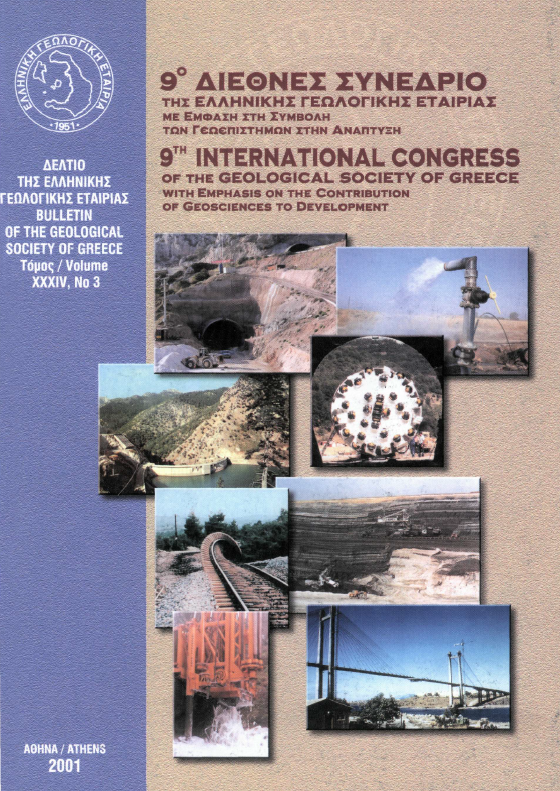Preliminary coal pétrographie study of the Achlada lignite deposit in the Florida domain

Abstract
The present paper is a first stage study of the Achlada lignite deposit (Fiorina Domain) from the coal petrography aspect, aiming at the lignite classification in lithotypes and the extraction of initial conclusions concerning the paleoenvironment of the lignite formation. The Achlada deposit spreads at the NE end of the east borderlands of the Fiorina basin of a SW-NE axis, occupies an area of approximately 7,2 Km2 and is a part of the broader tectonic trench of Monastirion-Florina- Ptolemais-Kozani-Servia, which is ΝW-SE directed and of Miocene age. Due to erosion processes, the lignite deposit with its host rocks is separated into two areas, the Northeastern, where greater thicknesses occur, and the Southwestern (KOTIS TH. et al., 1995). The lignite deposit consists of alternations of mostly thin lignite layers (of approximate thickness up to 23 m) with sediments. The sediments of the lignitiferous suite are mainly sands; mostly fine grained and every now and then clayey, rarely medium grained and including psephit. Besides the lignite layers, layers of humic clays often occur with fragments of xylite and flora residues every now and then. During the present study, which aimed at a forerunning coal pétrographie examination of the deposit, 12 lignite samples have been taken from two representative boreholes. This initial stage of the research shows that the primal macérais of the Achlada deposit basically belong to the huminite group and secondarily to the liptinite group, while the third corresponding category of the inertinite group almost vanishes. From the first category greater percentages are occupied by the macerai densinite (=31%) followed by attrinite (=25%), textoulminite (=22%) and eu-ulminite (=3%), while the second corresponding category gives cutinite (=8%), liptodetrinite (=3%), sporinite (=2,5%) and relatively low percentages of resinite and alginite. The participation of inorganic components is mainly characterized by the relatively low presence of pyrite and clay. According to the results of the coal pétrographie study and their quantative evaluation the following indexes have been calculated; gelification index (GI), vegetation index (VI), groundwater influence index (GWI) and tissue preservation index (TPI). With the correlation between these indexes and the use of diagrams, conclusions are derived concerning the paleoenvironment and the conditions of the lignite formation. From the VI/GWI relationship conclusions are derived concerning the hydrologie status and the nutritient components supply and from the TPI/GI relationship the paleoenvironment in relation to the groundwater level. The evaluation of the data shows that the host environment of the maternal flora was telmatic with mainly mesotrophic and partly rheotrophic conditions (swamp), while for a time period -at least- just before the end of the mire, the environment has changed into a wet area with more intensely telmatic conditions. The conditions of the peat formation were, of course, repeating -frequent alternations with sediments periodically- but always within the scope of a similar environment
Article Details
- How to Cite
-
ΑΝΤΩΝΙΑΔΗΣ Π. A., ΒΛΑΧΟΥ Α., ΑΜΠΑΤΖΗ Σ. Μ., KHANAGA Ρ., & RIEGEL, W. (2001). Preliminary coal pétrographie study of the Achlada lignite deposit in the Florida domain. Bulletin of the Geological Society of Greece, 34(3), 1185–1194. https://doi.org/10.12681/bgsg.17181
- Section
- Energy Resources

This work is licensed under a Creative Commons Attribution-NonCommercial 4.0 International License.
Authors who publish with this journal agree to the following terms:
Authors retain copyright and grant the journal right of first publication with the work simultaneously licensed under a Creative Commons Attribution Non-Commercial License that allows others to share the work with an acknowledgement of the work's authorship and initial publication in this journal.
Authors are able to enter into separate, additional contractual arrangements for the non-exclusive distribution of the journal's published version of the work (e.g. post it to an institutional repository or publish it in a book), with an acknowledgement of its initial publication in this journal. Authors are permitted and encouraged to post their work online (preferably in institutional repositories or on their website) prior to and during the submission process, as it can lead to productive exchanges, as well as earlier and greater citation of published work.


